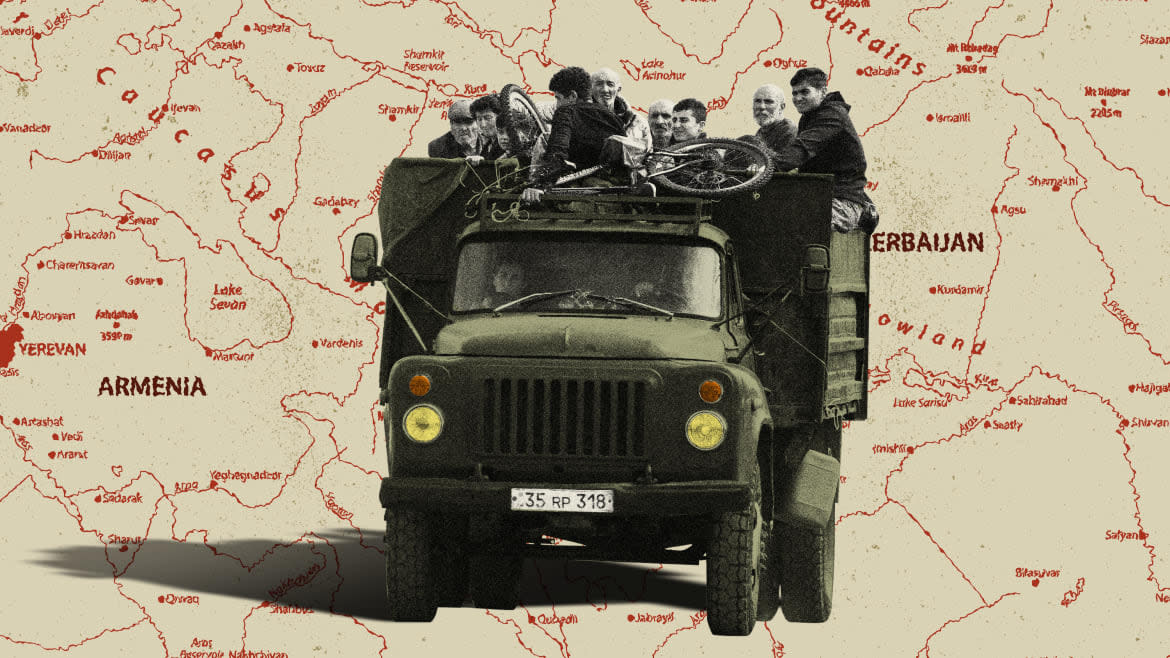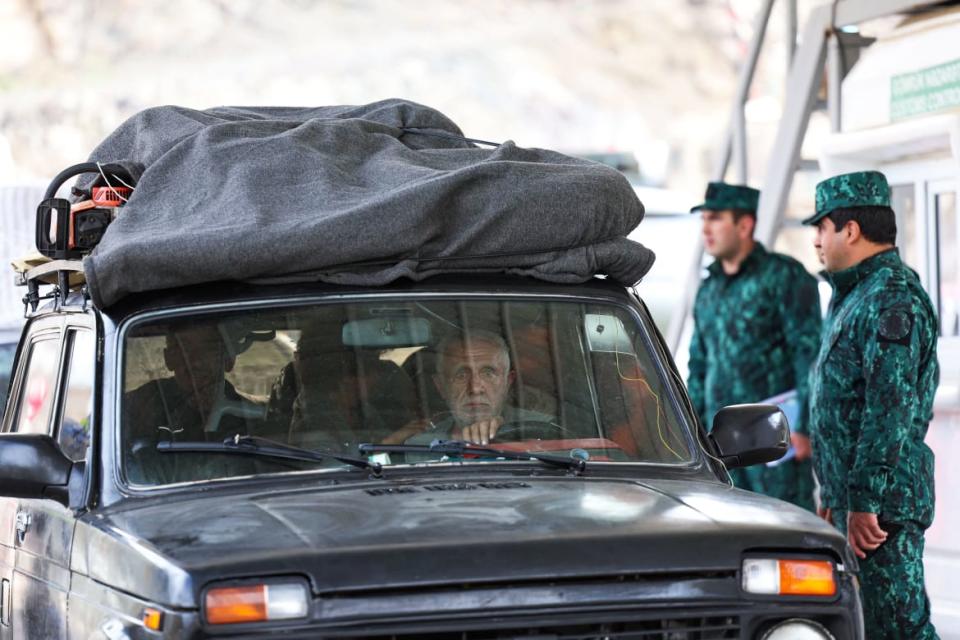Survivors Reveal War Crimes as Putin’s Men Stood Aside

GORIS, Armenia—Two ethnic Armenian soldiers who survived the blitzkrieg onslaught against Nagorno-Karabakh told The Daily Beast they witnessed apparent war crimes committed against civilians who lived in the disputed enclave.
Azerbaijan conducted the assault on Nagorno-Karabakh last week despite the presence of Russian peacekeepers who had been defending the residents of the border region. It took only two days for Azerbaijan to take control of the enclave after the assault began on Sept. 19. Armenian Prime Minister Nikol Pashinyan has since accused its Russian ally of failing to intervene.
One civilian allegedly had his leg cut in two by a bullet from a sniper that struck him during the attack, according to the soldiers. They also told The Daily Beast that they had witnessed indiscriminate shelling of civilian areas, in contravention of the International Criminal Court’s Rome Statue on war crimes.
The University Network For Human Rights, a non-governmental organization documenting crimes against humanity, is currently in Armenia collecting witness allegations of war crimes against Azerbaijani soldiers and citizens. Among the alleged crimes are attacks on civilian infrastructure, and forced deportation.
“People are fearful to say anything, because they still have relatives in Nagorno-Karabakh,” said Anoush Baghdassarin, a consultant attorney for The University Network For Human Rights, which has spoken to around 25 families in recent days about human rights violations during the war.
First Look Inside the Historic Mass Exodus Putin Failed to Prevent
“Every single person we have been speaking to is a victim of forced displacement and ethnic cleansing. We have been documenting their departure, we’ve been documenting what happened since last Tuesday, Sept. 19,” Baghdassarin told The Daily Beast.
“People have been telling us that as fast as they could, they went into bunkers or they fled into forests, and they had to leave behind the people who were too sick or too elderly to leave with them. Telling us [that] many of them are still missing, they haven’t heard from them, haven’t had any contact with them, and they don’t know if they are dead, where they are,” Baghdassarin said.
“We’ve been hearing a lot of stories of flight, of fear, of missing people, and of loss. People have left their homes. Thirty minutes before soldiers were coming to their village, they fled to the next village,” she added.
“When Armenians get to the border, Azerbaijan is scanning the car and going in and looking at the individuals in the car, and taking out the men. One woman told me she had read that one boy they took out of the car had his was cut off at the border, but it’s not corroborated,” Baghdassarin said.

Refugees wait in their car to leave Karabakh for Armenia, at the Lachin checkpoint, on Sept. 26, 2023.
Azerbaijan’s war on Nagorno-Karabakh was not something the breakaway region’s military expected. They were not prepared for the invasion and did not have enough bullets to ward off the enemy. They surrendered to Azerbaijan’s military in a matter of hours, leaving the homeland that residents refer to as “Artsakh” to occupation by Baku.
In a series of interviews with The Daily Beast, the two soldiers—who agreed to speak on condition of using only their first names—recounted additional horrors they say that have witnessed.
The fighting began around 1 p.m., Amik told The Daily Beast. He was at his military post, in a Nagorno-Karabakh village that he declined to name.

Refugees from Nagorno-Karabakh gather around a fire on the road leading to the Armenian border, in Nagorno-Karabakh, Sept. 25, 2023.
“We didn’t know it would start,” he said, sitting with his mother, father, and brother outside of a humanitarian aid center in Goris, Armenia. “We understood it won’t be a long war. There was no sense. We have limited people, we didn’t have weapons, we had one grenade launcher, but it didn’t shoot, there were no projectiles,” he added.
Azerbaijan quickly advanced on Nagorno-Karabakh, and Amik came face to face with the invading force. He said that first, his position was bombed by Azerbaijani soldiers. Then he saw in another area of the village that Russian peacekeepers, too, were under shelling. But shortly afterwards, Amik said, “We saw 50-60 guys head in our direction with weapons. We responded.”
‘No Artsakh Anymore’
Amik and his brigade fought for 24 hours before being forced to surrender to Azerbaijani soldiers. At that time, Amik said, “We saw killings of civilians; 13 kids died in Stepanakert. I saw how they bombed (civilians). They bombed with artillery, planes from Sushni,” a city in Nagorno-Karabakh that has been occupied by Azerbaijan since the 2020 war in the region.
“I saw injuries from shells and from bombing. There was a man with no hands or legs. There were dead in my unit, three to four people in each post. We shot back. Stayed for almost the whole day. On September 20, [the war] ended at 1:30 p.m.,” Amik added.
That was when Amik’s brigade was told by his commanding officers that the war was over and that it was time to surrender their weapons. “We knew they would kill us, we knew we would die,” he said.
Amik managed to escape through a forest that brought him to Stepanakert, where he met his family, who were already there waiting for him. “We felt like losers. We are here,” Amik said as he looked around at the humanitarian aid centers.
The soldier believes that Azerbaijani citizens will move into homes in Nagorno-Karabakh that have been deserted in the aftermath of the war. Meanwhile, Amik and the 70,000 other refugees from Nagorno-Karabakh are left with “No home, nothing. We don’t know where to go.”
Thousands of refugees are now facing the same experience as Amik. They do not know where they should go next, and many are still struggling to understand how their lives could be destroyed in just one day.

Vehicles carrying refugees from Nagorno-Karabakh wait to cross the Armenian border, in Nagorno-Karabakh, Sept. 25, 2023.
On the grounds of the same humanitarian aid center as Amik, a 22-year-old soldier named Robert was sitting with his grandmother, parents, and brother. He told The Daily Beast that he saw an Azerbaijani sniper “shoot the leg of a civilian,” which was sliced off by the bullet.
Robert was able to escape with his family while dressed in plain clothing. But he said he knew of other soldiers who were unable to get out of Nagorno-Karabakh.
“They [Azerbaijan] won’t let them leave. That’s what I have heard. I can’t explain this feeling. It’s very tough as my friends were fighting. The hardest is to lose friends,” said Robert
“There is no Artsakh anymore,” he added.
Get the Daily Beast's biggest scoops and scandals delivered right to your inbox. Sign up now.
Stay informed and gain unlimited access to the Daily Beast's unmatched reporting. Subscribe now.


